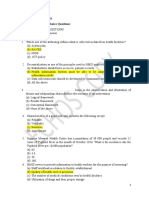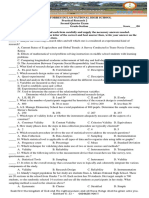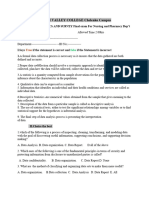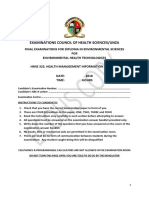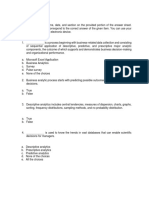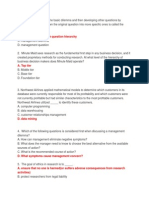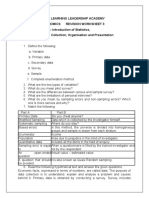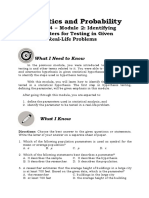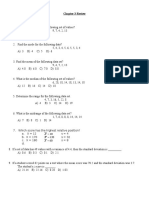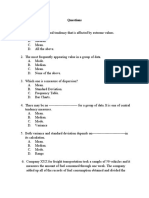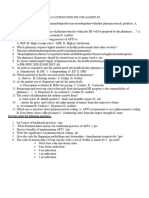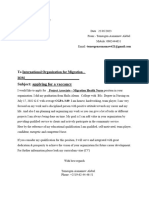Final Exam ABHS
Final Exam ABHS
Uploaded by
temesgen AsmamawCopyright:
Available Formats
Final Exam ABHS
Final Exam ABHS
Uploaded by
temesgen AsmamawOriginal Title
Copyright
Available Formats
Share this document
Did you find this document useful?
Is this content inappropriate?
Copyright:
Available Formats
Final Exam ABHS
Final Exam ABHS
Uploaded by
temesgen AsmamawCopyright:
Available Formats
HAILU ALEMU COLLEGE DEPARTMENTT OF PHARMACY APPLYING BASIC HEALTH STATISTICS AND SURVEY
FINAL EXAM (70%) 2015 e.c
I. Write True if the statement is correct and False if the statement is incorrect (2 point each)
1.________Inferential Statistics is used to reach a conclusion about a population based on the sample studied.
2.________Qualitative data can be expressed as a number.
3._______Data collection is the process of gathering and measuring information on targeted variables in an established system.
4.________Self-administered questionnaire is demand certain level of education and skill on the part of the respondents.
5.________Open-ended questions are not permit free responses that should be recorded in the respondent’s own words.
II.choose the best answer from the given alternatives and Use the Answer shaded it ( 3 point each)
6.____Which one of the f/f a list of possible options or answers from which the respondents must choose.
A) Closed ended Questions B) Open-ended questions C) Questionnaires D) All
7.____Which one of the f/f is simply describe the characteristics or attributes of the population under study.
A) Inferential statistics B) statistical methods C) Descriptive Statistics D) none
8.___The process of re-organization, classification, compilation, and summarization of data to present it in a meaningful form.
A) Presentation of the data B)Collection of data C)Organization of data D) All
9.____Which one of the f/f quantifies the magnitude of one occurrence or condition in relation to another.
A) Nominal scale B) Ratio scale C)Ordinal scale D) Interval scale
10.____Which one of the f/f the preventive measures that lead to early diagnosis and prompt treatment of a disease, illness or
injury to prevent more severe problems developing.
A) Primary prevention B) Secondary prevention C) Tertiary prevention D) All
11.____Which one of the following the most common type of health information – signs, symptoms, diagnoses, treatments and
outcome of the care process.
A) Clinical data B) Epidemiological data C)Demographic data D)Financial data
12.____ Which one of the following the process of gathering and measuring information on targeted variables in an established
system
A) Presentation of the data B) Organization of data C) Data collection D) all
13.____is simply the number of times the observation occurs in the data, divided by the total number of response.
A) Proportion B) number C) percentage D) none
14.____is a system that provides specific information support to the decision-making process at each level of an organization
A) Recording and reporting B) Health management information system C) Family Folder D)All
15. ____The process of extracting relevant information from the summarized data
A) Analysis of data B) Organization of data C) Data collection D) all
III.Match the item under column A with the correct answer under column B(3point each)
A B
16.____Modifiable risk factor A. simpler and cheaper
17.____Primary data B. smoking
18____Self-administered questionnaire C. inherited genes.
19____ Non-modifiablerisk factors D . Unique to the data collector or researcher
20.____ Number E. simply the total amount of the variable in the data.
IV.Write the answer for the following questions (2 point each)
21. Write the Importance of diagrammatic representation?
22. Writethe general rules of the construction of graphs?
23. Write the type of information’s collected by HMIS?
HAILU ALEMU COLLEGE DEPARTMENTT OF PHARMACY APPLYING BASIC HEALTH STATISTICS AND SURVEY
FINAL EXAM (70%) 2015 e.c
II. Write True if the statement is correct and False if the statement is incorrect (2 point each)
1.________Inferential Statistics is used to reach a conclusion about a population based on the sample studied.
2.________Qualitative data can be expressed as a number.
3._______Data collection is the process of gathering and measuring information on targeted variables in an established system.
4.________Self-administered questionnaire is demand certain level of education and skill on the part of the respondents.
5.________Open-ended questions are not permit free responses that should be recorded in the respondent’s own words.
II.choose the best answer from the given alternatives and Use the Answer shaded it ( 3 point each)
6.____Which one of the f/f a list of possible options or answers from which the respondents must choose.
A) Closed ended Questions B) Open-ended questions C) Questionnaires D) All
7.____Which one of the f/f is simply describe the characteristics or attributes of the population under study.
A) Inferential statistics B) statistical methods C) Descriptive Statistics D) none
8.___The process of re-organization, classification, compilation, and summarization of data to present it in a meaningful form.
A) Presentation of the data B)Collection of data C)Organization of data D) All
9.____Which one of the f/f quantifies the magnitude of one occurrence or condition in relation to another.
A) Nominal scale B) Ratio scale C)Ordinal scale D) Interval scale
10.____Which one of the f/f the preventive measures that lead to early diagnosis and prompt treatment of a disease, illness or
injury to prevent more severe problems developing.
A) Primary prevention B) Secondary prevention C) Tertiary prevention D) All
11.____Which one of the following the most common type of health information – signs, symptoms, diagnoses, treatments and
outcome of the care process.
B) Clinical data B) Epidemiological data C)Demographic data D)Financial data
12.____ Which one of the following the process of gathering and measuring information on targeted variables in an established
system
B) Presentation of the data B) Organization of data C) Data collection D) all
13.____is simply the number of times the observation occurs in the data, divided by the total number of response.
A) Proportion B) number C) percentage D) none
14.____is a system that provides specific information support to the decision-making process at each level of an organization
A) Recording and reporting B) Health management information system C) Family Folder D)All
15. ____The process of extracting relevant information from the summarized data
A) Analysis of data B) Organization of data C) Data collection D) all
III.Match the item under column A with the correct answer under column B(3point each)
A B
16.____Modifiable risk factor A. simpler and cheaper
17.____Primary data B. smoking
18____Self-administered questionnaire C. inherited genes.
19____ Non-modifiablerisk factors D . Unique to the data collector or researcher
20.____ Number E. simply the total amount of the variable in the data.
IV.Write the answer for the following questions (2 point each)
21. Write the Importance of diagrammatic representation?
22. Writethe general rules of the construction of graphs?
23.Write the type of information’s collected by HMIS?
HAILU ALEMU COLLEGE DEPARTMENTT OF PHARMACY APPLYING BASIC HEALTH STATISTICS AND SURVEY
FINAL EXAM (70%) 2015 e.c
III.Write True if the statement is correct and False if the statement is incorrect (2 point each)
1.________Inferential Statistics is used to reach a conclusion about a population based on the sample studied.
2.________Qualitative data can be expressed as a number.
3._______Data collection is the process of gathering and measuring information on targeted variables in an established system.
4.________Self-administered questionnaire is demand certain level of education and skill on the part of the respondents.
5.________Open-ended questions are not permit free responses that should be recorded in the respondent’s own words.
II.choose the best answer from the given alternatives and Use the Answer shaded it ( 3 point each)
6.____Which one of the f/f a list of possible options or answers from which the respondents must choose.
A) Closed ended Questions B) Open-ended questions C) Questionnaires D) All
7.____Which one of the f/f is simply describe the characteristics or attributes of the population under study.
A) Inferential statistics B) statistical methods C) Descriptive Statistics D) none
8.___The process of re-organization, classification, compilation, and summarization of data to present it in a meaningful form.
A) Presentation of the data B)Collection of data C)Organization of data D) All
9.____Which one of the f/f quantifies the magnitude of one occurrence or condition in relation to another.
A) Nominal scale B) Ratio scale C)Ordinal scale D) Interval scale
10.____Which one of the f/f the preventive measures that lead to early diagnosis and prompt treatment of a disease, illness or
injury to prevent more severe problems developing.
A) Primary prevention B) Secondary prevention C) Tertiary prevention D) All
11.____Which one of the following the most common type of health information – signs, symptoms, diagnoses, treatments and
outcome of the care process.
C) Clinical data B) Epidemiological data C)Demographic data D)Financial data
12.____ Which one of the following the process of gathering and measuring information on targeted variables in an established
system
C) Presentation of the data B) Organization of data C) Data collection D) all
13.____is simply the number of times the observation occurs in the data, divided by the total number of response.
A) Proportion B) number C) percentage D) none
14.____is a system that provides specific information support to the decision-making process at each level of an organization
A) Recording and reporting B) Health management information system C) Family Folder D)All
15. ____The process of extracting relevant information from the summarized data
A) Analysis of data B) Organization of data C) Data collection D) all
III.Match the item under column A with the correct answer under column B(3point each)
A B
16.____Modifiable risk factor A. simpler and cheaper
17.____Primary data B. smoking
18____Self-administered questionnaire C. inherited genes.
19____ Non-modifiablerisk factors D . Unique to the data collector or researcher
20.____ Number E. simply the total amount of the variable in the data.
IV.Write the answer for the following questions (2 point each)
21. Write the Importance of diagrammatic representation?
22. Writethe general rules of the construction of graphs?
23. Write the type of information’s collected by HMIS?
HAILU ALEMU COLLEGE DEPARTMENTT OF PHARMACY APPLYING BASIC HEALTH STATISTICS AND SURVEY
FINAL EXAM (70%) 2015 e.c
IV. Write True if the statement is correct and False if the statement is incorrect (2 point each)
1.________Inferential Statistics is used to reach a conclusion about a population based on the sample studied.
2.________Qualitative data can be expressed as a number.
3._______Data collection is the process of gathering and measuring information on targeted variables in an established system.
4.________Self-administered questionnaire is demand certain level of education and skill on the part of the respondents.
5.________Open-ended questions are not permit free responses that should be recorded in the respondent’s own words.
II.choose the best answer from the given alternatives and Use the Answer shaded it ( 3 point each)
6.____Which one of the f/f a list of possible options or answers from which the respondents must choose.
A) Closed ended Questions B) Open-ended questions C) Questionnaires D) All
7.____Which one of the f/f is simply describe the characteristics or attributes of the population under study.
A) Inferential statistics B) statistical methods C) Descriptive Statistics D) none
8.___The process of re-organization, classification, compilation, and summarization of data to present it in a meaningful form.
A) Presentation of the data B)Collection of data C)Organization of data D) All
9.____Which one of the f/f quantifies the magnitude of one occurrence or condition in relation to another.
A) Nominal scale B) Ratio scale C)Ordinal scale D) Interval scale
10.____Which one of the f/f the preventive measures that lead to early diagnosis and prompt treatment of a disease, illness or
injury to prevent more severe problems developing.
A) Primary prevention B) Secondary prevention C) Tertiary prevention D) All
11.____Which one of the following the most common type of health information – signs, symptoms, diagnoses, treatments and
outcome of the care process.
D) Clinical data B) Epidemiological data C)Demographic data D)Financial data
12.____ Which one of the following the process of gathering and measuring information on targeted variables in an established
system
D) Presentation of the data B) Organization of data C) Data collection D) all
13.____is simply the number of times the observation occurs in the data, divided by the total number of response.
A) Proportion B) number C) percentage D) none
14.____is a system that provides specific information support to the decision-making process at each level of an organization
A) Recording and reporting B) Health management information system C) Family Folder D)All
15. ____The process of extracting relevant information from the summarized data
A) Analysis of data B) Organization of data C) Data collection D) all
III.Match the item under column A with the correct answer under column B(3point each)
A B
16.____Modifiable risk factor A. simpler and cheaper
17.____Primary data B. smoking
18____Self-administered questionnaire C. inherited genes.
19____ Non-modifiablerisk factors D . Unique to the data collector or researcher
20.____ Number E. simply the total amount of the variable in the data.
IV.Write the answer for the following questions (2 point each)
21. Write the Importance of diagrammatic representation?
22. Writethe general rules of the construction of graphs?
23.Write the type of information’s collected by HMIS?
HAILU ALEMU COLLEGE DEPARTMENTT OF PHARMACY APPLYING BASIC HEALTH STATISTICS AND SURVEY
FINAL EXAM (70%) 2015 e.c
V. Write True if the statement is correct and False if the statement is incorrect (2 point each)
1.________Inferential Statistics is used to reach a conclusion about a population based on the sample studied.
2.________Qualitative data can be expressed as a number.
3._______Data collection is the process of gathering and measuring information on targeted variables in an established system.
4.________Self-administered questionnaire is demand certain level of education and skill on the part of the respondents.
5.________Open-ended questions are not permit free responses that should be recorded in the respondent’s own words.
II.choose the best answer from the given alternatives and Use the Answer shaded it ( 3 point each)
6.____Which one of the f/f a list of possible options or answers from which the respondents must choose.
A) Closed ended Questions B) Open-ended questions C) Questionnaires D) All
7.____Which one of the f/f is simply describe the characteristics or attributes of the population under study.
A) Inferential statistics B) statistical methods C) Descriptive Statistics D) none
8.___The process of re-organization, classification, compilation, and summarization of data to present it in a meaningful form.
A) Presentation of the data B)Collection of data C)Organization of data D) All
9.____Which one of the f/f quantifies the magnitude of one occurrence or condition in relation to another.
A) Nominal scale B) Ratio scale C)Ordinal scale D) Interval scale
10.____Which one of the f/f the preventive measures that lead to early diagnosis and prompt treatment of a disease, illness or
injury to prevent more severe problems developing.
A) Primary prevention B) Secondary prevention C) Tertiary prevention D) All
11.____Which one of the following the most common type of health information – signs, symptoms, diagnoses, treatments and
outcome of the care process.
E) Clinical data B) Epidemiological data C)Demographic data D)Financial data
12.____ Which one of the following the process of gathering and measuring information on targeted variables in an established
system
E) Presentation of the data B) Organization of data C) Data collection D) all
13.____is simply the number of times the observation occurs in the data, divided by the total number of response.
A) Proportion B) number C) percentage D) none
14.____is a system that provides specific information support to the decision-making process at each level of an organization
A) Recording and reporting B) Health management information system C) Family Folder D)All
15. ____The process of extracting relevant information from the summarized data
A) Analysis of data B) Organization of data C) Data collection D) all
III.Match the item under column A with the correct answer under column B(3point each)
A B
16.____Modifiable risk factor A. simpler and cheaper
17.____Primary data B. smoking
18____Self-administered questionnaire C. inherited genes.
19____ Non-modifiablerisk factors D . Unique to the data collector or researcher
20.____ Number E. simply the total amount of the variable in the data.
IV.Write the answer for the following questions (2 point each)
21. Write the Importance of diagrammatic representation?
22. Writethe general rules of the construction of graphs?
23. Write the type of information’s collected by HMIS?
HAILU ALEMU COLLEGE DEPARTMENTT OF PHARMACY APPLYING BASIC HEALTH STATISTICS AND SURVEY
FINAL EXAM (70%) 2015 e.c
VI. Write True if the statement is correct and False if the statement is incorrect (2 point each)
1.________Inferential Statistics is used to reach a conclusion about a population based on the sample studied.
2.________Qualitative data can be expressed as a number.
3._______Data collection is the process of gathering and measuring information on targeted variables in an established system.
4.________Self-administered questionnaire is demand certain level of education and skill on the part of the respondents.
5.________Open-ended questions are not permit free responses that should be recorded in the respondent’s own words.
II.choose the best answer from the given alternatives and Use the Answer shaded it ( 3 point each)
6.____Which one of the f/f a list of possible options or answers from which the respondents must choose.
A) Closed ended Questions B) Open-ended questions C) Questionnaires D) All
7.____Which one of the f/f is simply describe the characteristics or attributes of the population under study.
A) Inferential statistics B) statistical methods C) Descriptive Statistics D) none
8.___The process of re-organization, classification, compilation, and summarization of data to present it in a meaningful form.
A) Presentation of the data B)Collection of data C)Organization of data D) All
9.____Which one of the f/f quantifies the magnitude of one occurrence or condition in relation to another.
A) Nominal scale B) Ratio scale C)Ordinal scale D) Interval scale
10.____Which one of the f/f the preventive measures that lead to early diagnosis and prompt treatment of a disease, illness or
injury to prevent more severe problems developing.
A) Primary prevention B) Secondary prevention C) Tertiary prevention D) All
11.____Which one of the following the most common type of health information – signs, symptoms, diagnoses, treatments and
outcome of the care process.
F) Clinical data B) Epidemiological data C)Demographic data D)Financial data
12.____ Which one of the following the process of gathering and measuring information on targeted variables in an established
system
F) Presentation of the data B) Organization of data C) Data collection D) all
13.____is simply the number of times the observation occurs in the data, divided by the total number of response.
A) Proportion B) number C) percentage D) none
14.____is a system that provides specific information support to the decision-making process at each level of an organization
A) Recording and reporting B) Health management information system C) Family Folder D)All
15. ____The process of extracting relevant information from the summarized data
A) Analysis of data B) Organization of data C) Data collection D) all
III.Match the item under column A with the correct answer under column B(3point each)
A B
16.____Modifiable risk factor A. simpler and cheaper
17.____Primary data B. smoking
18____Self-administered questionnaire C. inherited genes.
19____ Non-modifiablerisk factors D . Unique to the data collector or researcher
20.____ Number E. simply the total amount of the variable in the data.
IV.Write the answer for the following questions (2 point each)
21. Write the Importance of diagrammatic representation?
22. Writethe general rules of the construction of graphs?
23. Write the type of information’s collected by HMIS?
HAILU ALEMU COLLEGE DEPARTMENTT OF PHARMACY APPLYING BASIC HEALTH STATISTICS AND SURVEY
FINAL EXAM (70%) 2015 e.c
VII. Write True if the statement is correct and False if the statement is incorrect (2 point each)
1.________Inferential Statistics is used to reach a conclusion about a population based on the sample studied.
2.________Qualitative data can be expressed as a number.
3._______Data collection is the process of gathering and measuring information on targeted variables in an established system.
4.________Self-administered questionnaire is demand certain level of education and skill on the part of the respondents.
5.________Open-ended questions are not permit free responses that should be recorded in the respondent’s own words.
II.choose the best answer from the given alternatives and Use the Answer shaded it ( 3 point each)
6.____Which one of the f/f a list of possible options or answers from which the respondents must choose.
A) Closed ended Questions B) Open-ended questions C) Questionnaires D) All
7.____Which one of the f/f is simply describe the characteristics or attributes of the population under study.
A) Inferential statistics B) statistical methods C) Descriptive Statistics D) none
8.___The process of re-organization, classification, compilation, and summarization of data to present it in a meaningful form.
A) Presentation of the data B)Collection of data C)Organization of data D) All
9.____Which one of the f/f quantifies the magnitude of one occurrence or condition in relation to another.
A) Nominal scale B) Ratio scale C)Ordinal scale D) Interval scale
10.____Which one of the f/f the preventive measures that lead to early diagnosis and prompt treatment of a disease, illness or
injury to prevent more severe problems developing.
A) Primary prevention B) Secondary prevention C) Tertiary prevention D) All
11.____Which one of the following the most common type of health information – signs, symptoms, diagnoses, treatments and
outcome of the care process.
G) Clinical data B) Epidemiological data C)Demographic data D)Financial data
12.____ Which one of the following the process of gathering and measuring information on targeted variables in an established
system
G) Presentation of the data B) Organization of data C) Data collection D) all
13.____is simply the number of times the observation occurs in the data, divided by the total number of response.
A) Proportion B) number C) percentage D) none
14.____is a system that provides specific information support to the decision-making process at each level of an organization
A) Recording and reporting B) Health management information system C) Family Folder D)All
15. ____The process of extracting relevant information from the summarized data
A) Analysis of data B) Organization of data C) Data collection D) all
III.Match the item under column A with the correct answer under column B(3point each)
A B
16.____Modifiable risk factor A. simpler and cheaper
17.____Primary data B. smoking
18____Self-administered questionnaire C. inherited genes.
19____ Non-modifiablerisk factors D . Unique to the data collector or researcher
20.____ Number E. simply the total amount of the variable in the data.
IV.Write the answer for the following questions (2 point each)
21. Write the Importance of diagrammatic representation?
22. Writethe general rules of the construction of graphs?
23. Write the type of information’s collected by HMIS?
HAILU ALEMU COLLEGE DEPARTMENTT OF PHARMACY APPLYING BASIC HEALTH STATISTICS AND SURVEY
FINAL EXAM (70%) 2015 e.c
VIII. Write True if the statement is correct and False if the statement is incorrect (2 point each)
1.________Inferential Statistics is used to reach a conclusion about a population based on the sample studied.
2.________Qualitative data can be expressed as a number.
3._______Data collection is the process of gathering and measuring information on targeted variables in an established system.
4.________Self-administered questionnaire is demand certain level of education and skill on the part of the respondents.
5.________Open-ended questions are not permit free responses that should be recorded in the respondent’s own words.
II.choose the best answer from the given alternatives and Use the Answer shaded it ( 3 point each)
6.____Which one of the f/f a list of possible options or answers from which the respondents must choose.
A) Closed ended Questions B) Open-ended questions C) Questionnaires D) All
7.____Which one of the f/f is simply describe the characteristics or attributes of the population under study.
A) Inferential statistics B) statistical methods C) Descriptive Statistics D) none
8.___The process of re-organization, classification, compilation, and summarization of data to present it in a meaningful form.
A) Presentation of the data B)Collection of data C)Organization of data D) All
9.____Which one of the f/f quantifies the magnitude of one occurrence or condition in relation to another.
A) Nominal scale B) Ratio scale C)Ordinal scale D) Interval scale
10.____Which one of the f/f the preventive measures that lead to early diagnosis and prompt treatment of a disease, illness or
injury to prevent more severe problems developing.
A) Primary prevention B) Secondary prevention C) Tertiary prevention D) All
11.____Which one of the following the most common type of health information – signs, symptoms, diagnoses, treatments and
outcome of the care process.
H) Clinical data B) Epidemiological data C)Demographic data D)Financial data
12.____ Which one of the following the process of gathering and measuring information on targeted variables in an established
system
H) Presentation of the data B) Organization of data C) Data collection D) all
13.____is simply the number of times the observation occurs in the data, divided by the total number of response.
A) Proportion B) number C) percentage D) none
14.____is a system that provides specific information support to the decision-making process at each level of an organization
A) Recording and reporting B) Health management information system C) Family Folder D)All
15. ____The process of extracting relevant information from the summarized data
A) Analysis of data B) Organization of data C) Data collection D) all
III.Match the item under column A with the correct answer under column B(3point each)
A B
16.____Modifiable risk factor A. simpler and cheaper
17.____Primary data B. smoking
18____Self-administered questionnaire C. inherited genes.
19____ Non-modifiablerisk factors D . Unique to the data collector or researcher
20.____ Number E. simply the total amount of the variable in the data.
IV.Write the answer for the following questions (2 point each)
21. Write the Importance of diagrammatic representation?
22. Writethe general rules of the construction of graphs?
23. Write the type of information’s collected by HMIS?
HAILU ALEMU COLLEGE DEPARTMENTT OF PHARMACY APPLYING BASIC HEALTH STATISTICS AND SURVEY
FINAL EXAM (70%) 2015 e.c
IX. Write True if the statement is correct and False if the statement is incorrect (2 point each)
1.________Inferential Statistics is used to reach a conclusion about a population based on the sample studied.
2.________Qualitative data can be expressed as a number.
3._______Data collection is the process of gathering and measuring information on targeted variables in an established system.
4.________Self-administered questionnaire is demand certain level of education and skill on the part of the respondents.
5.________Open-ended questions are not permit free responses that should be recorded in the respondent’s own words.
II.choose the best answer from the given alternatives and Use the Answer shaded it ( 3 point each)
6.____Which one of the f/f a list of possible options or answers from which the respondents must choose.
A) Closed ended Questions B) Open-ended questions C) Questionnaires D) All
7.____Which one of the f/f is simply describe the characteristics or attributes of the population under study.
A) Inferential statistics B) statistical methods C) Descriptive Statistics D) none
8.___The process of re-organization, classification, compilation, and summarization of data to present it in a meaningful form.
A) Presentation of the data B)Collection of data C)Organization of data D) All
9.____Which one of the f/f quantifies the magnitude of one occurrence or condition in relation to another.
A) Nominal scale B) Ratio scale C)Ordinal scale D) Interval scale
10.____Which one of the f/f the preventive measures that lead to early diagnosis and prompt treatment of a disease, illness or
injury to prevent more severe problems developing.
A) Primary prevention B) Secondary prevention C) Tertiary prevention D) All
11.____Which one of the following the most common type of health information – signs, symptoms, diagnoses, treatments and
outcome of the care process.
I) Clinical data B) Epidemiological data C)Demographic data D)Financial data
12.____ Which one of the following the process of gathering and measuring information on targeted variables in an established
system
I) Presentation of the data B) Organization of data C) Data collection D) all
13.____is simply the number of times the observation occurs in the data, divided by the total number of response.
A) Proportion B) number C) percentage D) none
14.____is a system that provides specific information support to the decision-making process at each level of an organization
A) Recording and reporting B) Health management information system C) Family Folder D)All
15. ____The process of extracting relevant information from the summarized data
A) Analysis of data B) Organization of data C) Data collection D) all
III.Match the item under column A with the correct answer under column B(3point each)
A B
16.____Modifiable risk factor A. simpler and cheaper
17.____Primary data B. smoking
18____Self-administered questionnaire C. inherited genes.
19____ Non-modifiablerisk factors D . Unique to the data collector or researcher
20.____ Number E. simply the total amount of the variable in the data.
IV.Write the answer for the following questions (2 point each)
21. Write the Importance of diagrammatic representation?
22. Writethe general rules of the construction of graphs?
23. Write the type of information’s collected by HMIS?
HAILU ALEMU COLLEGE DEPARTMENTT OF PHARMACY APPLYING BASIC HEALTH STATISTICS AND SURVEY
FINAL EXAM (70%) 2015 e.c
X. Write True if the statement is correct and False if the statement is incorrect (2 point each)
1.________Inferential Statistics is used to reach a conclusion about a population based on the sample studied.
2.________Qualitative data can be expressed as a number.
3._______Data collection is the process of gathering and measuring information on targeted variables in an established system.
4.________Self-administered questionnaire is demand certain level of education and skill on the part of the respondents.
5.________Open-ended questions are not permit free responses that should be recorded in the respondent’s own words.
II.choose the best answer from the given alternatives and Use the Answer shaded it ( 3 point each)
6.____Which one of the f/f a list of possible options or answers from which the respondents must choose.
A) Closed ended Questions B) Open-ended questions C) Questionnaires D) All
7.____Which one of the f/f is simply describe the characteristics or attributes of the population under study.
A) Inferential statistics B) statistical methods C) Descriptive Statistics D) none
8.___The process of re-organization, classification, compilation, and summarization of data to present it in a meaningful form.
A) Presentation of the data B)Collection of data C)Organization of data D) All
9.____Which one of the f/f quantifies the magnitude of one occurrence or condition in relation to another.
A) Nominal scale B) Ratio scale C)Ordinal scale D) Interval scale
10.____Which one of the f/f the preventive measures that lead to early diagnosis and prompt treatment of a disease, illness or
injury to prevent more severe problems developing.
A) Primary prevention B) Secondary prevention C) Tertiary prevention D) All
11.____Which one of the following the most common type of health information – signs, symptoms, diagnoses, treatments and
outcome of the care process.
J) Clinical data B) Epidemiological data C)Demographic data D)Financial data
12.____ Which one of the following the process of gathering and measuring information on targeted variables in an established
system
J) Presentation of the data B) Organization of data C) Data collection D) all
13.____is simply the number of times the observation occurs in the data, divided by the total number of response.
A) Proportion B) number C) percentage D) none
14.____is a system that provides specific information support to the decision-making process at each level of an organization
A) Recording and reporting B) Health management information system C) Family Folder D)All
15. ____The process of extracting relevant information from the summarized data
A) Analysis of data B) Organization of data C) Data collection D) all
III.Match the item under column A with the correct answer under column B(3point each)
A B
16.____Modifiable risk factor A. simpler and cheaper
17.____Primary data B. smoking
18____Self-administered questionnaire C. inherited genes.
19____ Non-modifiablerisk factors D . Unique to the data collector or researcher
20.____ Number E. simply the total amount of the variable in the data.
IV.Write the answer for the following questions (2 point each)
21. Write the Importance of diagrammatic representation?
22. Writethe general rules of the construction of graphs?
23. Write the type of information’s collected by HMIS?
HAILU ALEMU COLLEGE DEPARTMENTT OF PHARMACY APPLYING BASIC HEALTH STATISTICS AND SURVEY
FINAL EXAM (70%) 2015 e.c
XI. Write True if the statement is correct and False if the statement is incorrect (2 point each)
1.________Inferential Statistics is used to reach a conclusion about a population based on the sample studied.
2.________Qualitative data can be expressed as a number.
3._______Data collection is the process of gathering and measuring information on targeted variables in an established system.
4.________Self-administered questionnaire is demand certain level of education and skill on the part of the respondents.
5.________Open-ended questions are not permit free responses that should be recorded in the respondent’s own words.
II.choose the best answer from the given alternatives and Use the Answer shaded it ( 3 point each)
6.____Which one of the f/f a list of possible options or answers from which the respondents must choose.
A) Closed ended Questions B) Open-ended questions C) Questionnaires D) All
7.____Which one of the f/f is simply describe the characteristics or attributes of the population under study.
A) Inferential statistics B) statistical methods C) Descriptive Statistics D) none
8.___The process of re-organization, classification, compilation, and summarization of data to present it in a meaningful form.
A) Presentation of the data B)Collection of data C)Organization of data D) All
9.____Which one of the f/f quantifies the magnitude of one occurrence or condition in relation to another.
A) Nominal scale B) Ratio scale C)Ordinal scale D) Interval scale
10.____Which one of the f/f the preventive measures that lead to early diagnosis and prompt treatment of a disease, illness or
injury to prevent more severe problems developing.
A) Primary prevention B) Secondary prevention C) Tertiary prevention D) All
11.____Which one of the following the most common type of health information – signs, symptoms, diagnoses, treatments and
outcome of the care process.
K) Clinical data B) Epidemiological data C)Demographic data D)Financial data
12.____ Which one of the following the process of gathering and measuring information on targeted variables in an established
system
K) Presentation of the data B) Organization of data C) Data collection D) all
13.____is simply the number of times the observation occurs in the data, divided by the total number of response.
A) Proportion B) number C) percentage D) none
14.____is a system that provides specific information support to the decision-making process at each level of an organization
A) Recording and reporting B) Health management information system C) Family Folder D)All
15. ____The process of extracting relevant information from the summarized data
A) Analysis of data B) Organization of data C) Data collection D) all
III.Match the item under column A with the correct answer under column B(3point each)
A B
16.____Modifiable risk factor A. simpler and cheaper
17.____Primary data B. smoking
18____Self-administered questionnaire C. inherited genes.
19____ Non-modifiablerisk factors D . Unique to the data collector or researcher
20.____ Number E. simply the total amount of the variable in the data.
IV.Write the answer for the following questions (2 point each)
21. Write the Importance of diagrammatic representation?
22. Writethe general rules of the construction of graphs?
23. Write the type of information’s collected by HMIS?
HAILU ALEMU COLLEGE DEPARTMENTT OF PHARMACY APPLYING BASIC HEALTH STATISTICS AND SURVEY
FINAL EXAM (70%) 2015 e.c
XII. Write True if the statement is correct and False if the statement is incorrect (2 point each)
1.________Inferential Statistics is used to reach a conclusion about a population based on the sample studied.
2.________Qualitative data can be expressed as a number.
3._______Data collection is the process of gathering and measuring information on targeted variables in an established system.
4.________Self-administered questionnaire is demand certain level of education and skill on the part of the respondents.
5.________Open-ended questions are not permit free responses that should be recorded in the respondent’s own words.
II.choose the best answer from the given alternatives and Use the Answer shaded it ( 3 point each)
6.____Which one of the f/f a list of possible options or answers from which the respondents must choose.
A) Closed ended Questions B) Open-ended questions C) Questionnaires D) All
7.____Which one of the f/f is simply describe the characteristics or attributes of the population under study.
A) Inferential statistics B) statistical methods C) Descriptive Statistics D) none
8.___The process of re-organization, classification, compilation, and summarization of data to present it in a meaningful form.
A) Presentation of the data B)Collection of data C)Organization of data D) All
9.____Which one of the f/f quantifies the magnitude of one occurrence or condition in relation to another.
A) Nominal scale B) Ratio scale C)Ordinal scale D) Interval scale
10.____Which one of the f/f the preventive measures that lead to early diagnosis and prompt treatment of a disease, illness or
injury to prevent more severe problems developing.
A) Primary prevention B) Secondary prevention C) Tertiary prevention D) All
11.____Which one of the following the most common type of health information – signs, symptoms, diagnoses, treatments and
outcome of the care process.
L) Clinical data B) Epidemiological data C)Demographic data D)Financial data
12.____ Which one of the following the process of gathering and measuring information on targeted variables in an established
system
L) Presentation of the data B) Organization of data C) Data collection D) all
13.____is simply the number of times the observation occurs in the data, divided by the total number of response.
A) Proportion B) number C) percentage D) none
14.____is a system that provides specific information support to the decision-making process at each level of an organization
A) Recording and reporting B) Health management information system C) Family Folder D)All
15. ____The process of extracting relevant information from the summarized data
A) Analysis of data B) Organization of data C) Data collection D) all
III.Match the item under column A with the correct answer under column B(3point each)
A B
16.____Modifiable risk factor A. simpler and cheaper
17.____Primary data B. smoking
18____Self-administered questionnaire C. inherited genes.
19____ Non-modifiablerisk factors D . Unique to the data collector or researcher
20.____ Number E. simply the total amount of the variable in the data.
IV.Write the answer for the following questions (2 point each)
21. Write the Importance of diagrammatic representation?
22. Writethe general rules of the construction of graphs?
23. Write the type of information’s collected by HMIS?
HAILU ALEMU COLLEGE DEPARTMENTT OF PHARMACY APPLYING BASIC HEALTH STATISTICS AND SURVEY
FINAL EXAM (70%) 2015 e.c
XIII. Write True if the statement is correct and False if the statement is incorrect (2 point each)
1.________Inferential Statistics is used to reach a conclusion about a population based on the sample studied.
2.________Qualitative data can be expressed as a number.
3._______Data collection is the process of gathering and measuring information on targeted variables in an established system.
4.________Self-administered questionnaire is demand certain level of education and skill on the part of the respondents.
5.________Open-ended questions are not permit free responses that should be recorded in the respondent’s own words.
II.choose the best answer from the given alternatives and Use the Answer shaded it ( 3 point each)
6.____Which one of the f/f a list of possible options or answers from which the respondents must choose.
A) Closed ended Questions B) Open-ended questions C) Questionnaires D) All
7.____Which one of the f/f is simply describe the characteristics or attributes of the population under study.
A) Inferential statistics B) statistical methods C) Descriptive Statistics D) none
8.___The process of re-organization, classification, compilation, and summarization of data to present it in a meaningful form.
A) Presentation of the data B)Collection of data C)Organization of data D) All
9.____Which one of the f/f quantifies the magnitude of one occurrence or condition in relation to another.
A) Nominal scale B) Ratio scale C)Ordinal scale D) Interval scale
10.____Which one of the f/f the preventive measures that lead to early diagnosis and prompt treatment of a disease, illness or
injury to prevent more severe problems developing.
A) Primary prevention B) Secondary prevention C) Tertiary prevention D) All
11.____Which one of the following the most common type of health information – signs, symptoms, diagnoses, treatments and
outcome of the care process.
M) Clinical data B) Epidemiological data C)Demographic data D)Financial data
12.____ Which one of the following the process of gathering and measuring information on targeted variables in an established
system
M) Presentation of the data B) Organization of data C) Data collection D) all
13.____is simply the number of times the observation occurs in the data, divided by the total number of response.
A) Proportion B) number C) percentage D) none
14.____is a system that provides specific information support to the decision-making process at each level of an organization
A) Recording and reporting B) Health management information system C) Family Folder D)All
15. ____The process of extracting relevant information from the summarized data
A) Analysis of data B) Organization of data C) Data collection D) all
III.Match the item under column A with the correct answer under column B(3point each)
A B
16.____Modifiable risk factor A. simpler and cheaper
17.____Primary data B. smoking
18____Self-administered questionnaire C. inherited genes.
19____ Non-modifiablerisk factors D . Unique to the data collector or researcher
20.____ Number E. simply the total amount of the variable in the data.
IV.Write the answer for the following questions (2 point each)
21. Write the Importance of diagrammatic representation?
22. Writethe general rules of the construction of graphs?
23. Write the type of information’s collected by HMIS?
HAILU ALEMU COLLEGE DEPARTMENTT OF PHARMACY APPLYING BASIC HEALTH STATISTICS AND SURVEY
FINAL EXAM (70%) 2015 e.c
XIV. Write True if the statement is correct and False if the statement is incorrect (2 point each)
1.________Inferential Statistics is used to reach a conclusion about a population based on the sample studied.
2.________Qualitative data can be expressed as a number.
3._______Data collection is the process of gathering and measuring information on targeted variables in an established system.
4.________Self-administered questionnaire is demand certain level of education and skill on the part of the respondents.
5.________Open-ended questions are not permit free responses that should be recorded in the respondent’s own words.
II.choose the best answer from the given alternatives and Use the Answer shaded it ( 3 point each)
6.____Which one of the f/f a list of possible options or answers from which the respondents must choose.
A) Closed ended Questions B) Open-ended questions C) Questionnaires D) All
7.____Which one of the f/f is simply describe the characteristics or attributes of the population under study.
A) Inferential statistics B) statistical methods C) Descriptive Statistics D) none
8.___The process of re-organization, classification, compilation, and summarization of data to present it in a meaningful form.
A) Presentation of the data B)Collection of data C)Organization of data D) All
9.____Which one of the f/f quantifies the magnitude of one occurrence or condition in relation to another.
A) Nominal scale B) Ratio scale C)Ordinal scale D) Interval scale
10.____Which one of the f/f the preventive measures that lead to early diagnosis and prompt treatment of a disease, illness or
injury to prevent more severe problems developing.
A) Primary prevention B) Secondary prevention C) Tertiary prevention D) All
11.____Which one of the following the most common type of health information – signs, symptoms, diagnoses, treatments and
outcome of the care process.
N) Clinical data B) Epidemiological data C)Demographic data D)Financial data
12.____ Which one of the following the process of gathering and measuring information on targeted variables in an established
system
N) Presentation of the data B) Organization of data C) Data collection D) all
13.____is simply the number of times the observation occurs in the data, divided by the total number of response.
A) Proportion B) number C) percentage D) none
14.____is a system that provides specific information support to the decision-making process at each level of an organization
A) Recording and reporting B) Health management information system C) Family Folder D)All
15. ____The process of extracting relevant information from the summarized data
A) Analysis of data B) Organization of data C) Data collection D) all
III.Match the item under column A with the correct answer under column B(3point each)
A B
16.____Modifiable risk factor A. simpler and cheaper
17.____Primary data B. smoking
18____Self-administered questionnaire C. inherited genes.
19____ Non-modifiablerisk factors D . Unique to the data collector or researcher
20.____ Number E. simply the total amount of the variable in the data.
IV.Write the answer for the following questions (2 point each)
21. Write the Importance of diagrammatic representation?
22. Writethe general rules of the construction of graphs?
23. Write the type of information’s collected by HMIS?
HAILU ALEMU COLLEGE DEPARTMENTT OF PHARMACY APPLYING BASIC HEALTH STATISTICS AND SURVEY
FINAL EXAM (70%) 2015 e.c
XV. Write True if the statement is correct and False if the statement is incorrect (2 point each)
1.________Inferential Statistics is used to reach a conclusion about a population based on the sample studied.
2.________Qualitative data can be expressed as a number.
3._______Data collection is the process of gathering and measuring information on targeted variables in an established system.
4.________Self-administered questionnaire is demand certain level of education and skill on the part of the respondents.
5.________Open-ended questions are not permit free responses that should be recorded in the respondent’s own words.
II.choose the best answer from the given alternatives and Use the Answer shaded it ( 3 point each)
6.____Which one of the f/f a list of possible options or answers from which the respondents must choose.
A) Closed ended Questions B) Open-ended questions C) Questionnaires D) All
7.____Which one of the f/f is simply describe the characteristics or attributes of the population under study.
A) Inferential statistics B) statistical methods C) Descriptive Statistics D) none
8.___The process of re-organization, classification, compilation, and summarization of data to present it in a meaningful form.
A) Presentation of the data B)Collection of data C)Organization of data D) All
9.____Which one of the f/f quantifies the magnitude of one occurrence or condition in relation to another.
A) Nominal scale B) Ratio scale C)Ordinal scale D) Interval scale
10.____Which one of the f/f the preventive measures that lead to early diagnosis and prompt treatment of a disease, illness or
injury to prevent more severe problems developing.
A) Primary prevention B) Secondary prevention C) Tertiary prevention D) All
11.____Which one of the following the most common type of health information – signs, symptoms, diagnoses, treatments and
outcome of the care process.
O) Clinical data B) Epidemiological data C)Demographic data D)Financial data
12.____ Which one of the following the process of gathering and measuring information on targeted variables in an established
system
O) Presentation of the data B) Organization of data C) Data collection D) all
13.____is simply the number of times the observation occurs in the data, divided by the total number of response.
A) Proportion B) number C) percentage D) none
14.____is a system that provides specific information support to the decision-making process at each level of an organization
A) Recording and reporting B) Health management information system C) Family Folder D)All
15. ____The process of extracting relevant information from the summarized data
A) Analysis of data B) Organization of data C) Data collection D) all
III.Match the item under column A with the correct answer under column B(3point each)
A B
16.____Modifiable risk factor A. simpler and cheaper
17.____Primary data B. smoking
18____Self-administered questionnaire C. inherited genes.
19____ Non-modifiablerisk factors D . Unique to the data collector or researcher
20.____ Number E. simply the total amount of the variable in the data.
IV.Write the answer for the following questions (2 point each)
21. Write the Importance of diagrammatic representation?
22. Writethe general rules of the construction of graphs?
23. Write the type of information’s collected by HMIS?
HAILU ALEMU COLLEGE DEPARTMENTT OF PHARMACY APPLYING BASIC HEALTH STATISTICS AND SURVEY
FINAL EXAM (70%) 2015 e.c
XVI. Write True if the statement is correct and False if the statement is incorrect (2 point each)
1.________Inferential Statistics is used to reach a conclusion about a population based on the sample studied.
2.________Qualitative data can be expressed as a number.
3._______Data collection is the process of gathering and measuring information on targeted variables in an established system.
4.________Self-administered questionnaire is demand certain level of education and skill on the part of the respondents.
5.________Open-ended questions are not permit free responses that should be recorded in the respondent’s own words.
II.choose the best answer from the given alternatives and Use the Answer shaded it ( 3 point each)
6.____Which one of the f/f a list of possible options or answers from which the respondents must choose.
A) Closed ended Questions B) Open-ended questions C) Questionnaires D) All
7.____Which one of the f/f is simply describe the characteristics or attributes of the population under study.
A) Inferential statistics B) statistical methods C) Descriptive Statistics D) none
8.___The process of re-organization, classification, compilation, and summarization of data to present it in a meaningful form.
A) Presentation of the data B)Collection of data C)Organization of data D) All
9.____Which one of the f/f quantifies the magnitude of one occurrence or condition in relation to another.
A) Nominal scale B) Ratio scale C)Ordinal scale D) Interval scale
10.____Which one of the f/f the preventive measures that lead to early diagnosis and prompt treatment of a disease, illness or
injury to prevent more severe problems developing.
A) Primary prevention B) Secondary prevention C) Tertiary prevention D) All
11.____Which one of the following the most common type of health information – signs, symptoms, diagnoses, treatments and
outcome of the care process.
P) Clinical data B) Epidemiological data C)Demographic data D)Financial data
12.____ Which one of the following the process of gathering and measuring information on targeted variables in an established
system
P) Presentation of the data B) Organization of data C) Data collection D) all
13.____is simply the number of times the observation occurs in the data, divided by the total number of response.
A) Proportion B) number C) percentage D) none
14.____is a system that provides specific information support to the decision-making process at each level of an organization
A) Recording and reporting B) Health management information system C) Family Folder D)All
15. ____The process of extracting relevant information from the summarized data
A) Analysis of data B) Organization of data C) Data collection D) all
III.Match the item under column A with the correct answer under column B(3point each)
A B
16.____Modifiable risk factor A. simpler and cheaper
17.____Primary data B. smoking
18____Self-administered questionnaire C. inherited genes.
19____ Non-modifiablerisk factors D . Unique to the data collector or researcher
20.____ Number E. simply the total amount of the variable in the data.
IV.Write the answer for the following questions (2 point each)
21. Write the Importance of diagrammatic representation?
22. Writethe general rules of the construction of graphs?
23. Write the type of information’s collected by HMIS?
HAILU ALEMU COLLEGE DEPARTMENTT OF PHARMACY APPLYING BASIC HEALTH STATISTICS AND SURVEY
FINAL EXAM (70%) 2015 e.c
XVII. Write True if the statement is correct and False if the statement is incorrect (2 point each)
1.________Inferential Statistics is used to reach a conclusion about a population based on the sample studied.
2.________Qualitative data can be expressed as a number.
3._______Data collection is the process of gathering and measuring information on targeted variables in an established system.
4.________Self-administered questionnaire is demand certain level of education and skill on the part of the respondents.
5.________Open-ended questions are not permit free responses that should be recorded in the respondent’s own words.
II.choose the best answer from the given alternatives and Use the Answer shaded it ( 3 point each)
6.____Which one of the f/f a list of possible options or answers from which the respondents must choose.
A) Closed ended Questions B) Open-ended questions C) Questionnaires D) All
7.____Which one of the f/f is simply describe the characteristics or attributes of the population under study.
A) Inferential statistics B) statistical methods C) Descriptive Statistics D) none
8.___The process of re-organization, classification, compilation, and summarization of data to present it in a meaningful form.
A) Presentation of the data B)Collection of data C)Organization of data D) All
9.____Which one of the f/f quantifies the magnitude of one occurrence or condition in relation to another.
A) Nominal scale B) Ratio scale C)Ordinal scale D) Interval scale
10.____Which one of the f/f the preventive measures that lead to early diagnosis and prompt treatment of a disease, illness or
injury to prevent more severe problems developing.
A) Primary prevention B) Secondary prevention C) Tertiary prevention D) All
11.____Which one of the following the most common type of health information – signs, symptoms, diagnoses, treatments and
outcome of the care process.
Q) Clinical data B) Epidemiological data C)Demographic data D)Financial data
12.____ Which one of the following the process of gathering and measuring information on targeted variables in an established
system
Q) Presentation of the data B) Organization of data C) Data collection D) all
13.____is simply the number of times the observation occurs in the data, divided by the total number of response.
A) Proportion B) number C) percentage D) none
14.____is a system that provides specific information support to the decision-making process at each level of an organization
A) Recording and reporting B) Health management information system C) Family Folder D)All
15. ____The process of extracting relevant information from the summarized data
A) Analysis of data B) Organization of data C) Data collection D) all
III.Match the item under column A with the correct answer under column B(3point each)
A B
16.____Modifiable risk factor A. simpler and cheaper
17.____Primary data B. smoking
18____Self-administered questionnaire C. inherited genes.
19____ Non-modifiablerisk factors D . Unique to the data collector or researcher
20.____ Number E. simply the total amount of the variable in the data.
IV.Write the answer for the following questions (2 point each)
21. Write the Importance of diagrammatic representation?
22. Writethe general rules of the construction of graphs?
23. Write the type of information’s collected by HMIS?
HAILU ALEMU COLLEGE DEPARTMENTT OF PHARMACY APPLYING BASIC HEALTH STATISTICS AND SURVEY
FINAL EXAM (70%) 2015 e.c
XVIII. Write True if the statement is correct and False if the statement is incorrect (2 point each)
1.________Inferential Statistics is used to reach a conclusion about a population based on the sample studied.
2.________Qualitative data can be expressed as a number.
3._______Data collection is the process of gathering and measuring information on targeted variables in an established system.
4.________Self-administered questionnaire is demand certain level of education and skill on the part of the respondents.
5.________Open-ended questions are not permit free responses that should be recorded in the respondent’s own words.
II.choose the best answer from the given alternatives and Use the Answer shaded it ( 3 point each)
6.____Which one of the f/f a list of possible options or answers from which the respondents must choose.
A) Closed ended Questions B) Open-ended questions C) Questionnaires D) All
7.____Which one of the f/f is simply describe the characteristics or attributes of the population under study.
A) Inferential statistics B) statistical methods C) Descriptive Statistics D) none
8.___The process of re-organization, classification, compilation, and summarization of data to present it in a meaningful form.
A) Presentation of the data B)Collection of data C)Organization of data D) All
9.____Which one of the f/f quantifies the magnitude of one occurrence or condition in relation to another.
A) Nominal scale B) Ratio scale C)Ordinal scale D) Interval scale
10.____Which one of the f/f the preventive measures that lead to early diagnosis and prompt treatment of a disease, illness or
injury to prevent more severe problems developing.
A) Primary prevention B) Secondary prevention C) Tertiary prevention D) All
11.____Which one of the following the most common type of health information – signs, symptoms, diagnoses, treatments and
outcome of the care process.
R) Clinical data B) Epidemiological data C)Demographic data D)Financial data
12.____ Which one of the following the process of gathering and measuring information on targeted variables in an established
system
R) Presentation of the data B) Organization of data C) Data collection D) all
13.____is simply the number of times the observation occurs in the data, divided by the total number of response.
A) Proportion B) number C) percentage D) none
14.____is a system that provides specific information support to the decision-making process at each level of an organization
A) Recording and reporting B) Health management information system C) Family Folder D)All
15. ____The process of extracting relevant information from the summarized data
A) Analysis of data B) Organization of data C) Data collection D) all
III.Match the item under column A with the correct answer under column B(3point each)
A B
16.____Modifiable risk factor A. simpler and cheaper
17.____Primary data B. smoking
18____Self-administered questionnaire C. inherited genes.
19____ Non-modifiablerisk factors D . Unique to the data collector or researcher
20.____ Number E. simply the total amount of the variable in the data.
IV.Write the answer for the following questions (2 point each)
21. Write the Importance of diagrammatic representation?
22. Writethe general rules of the construction of graphs?
23. Write the type of information’s collected by HMIS?
HAILU ALEMU COLLEGE DEPARTMENTT OF PHARMACY APPLYING BASIC HEALTH STATISTICS AND SURVEY
FINAL EXAM (70%) 2015 e.c
XIX. Write True if the statement is correct and False if the statement is incorrect (2 point each)
1.________Inferential Statistics is used to reach a conclusion about a population based on the sample studied.
2.________Qualitative data can be expressed as a number.
3._______Data collection is the process of gathering and measuring information on targeted variables in an established system.
4.________Self-administered questionnaire is demand certain level of education and skill on the part of the respondents.
5.________Open-ended questions are not permit free responses that should be recorded in the respondent’s own words.
II.choose the best answer from the given alternatives and Use the Answer shaded it ( 3 point each)
6.____Which one of the f/f a list of possible options or answers from which the respondents must choose.
A) Closed ended Questions B) Open-ended questions C) Questionnaires D) All
7.____Which one of the f/f is simply describe the characteristics or attributes of the population under study.
A) Inferential statistics B) statistical methods C) Descriptive Statistics D) none
8.___The process of re-organization, classification, compilation, and summarization of data to present it in a meaningful form.
A) Presentation of the data B)Collection of data C)Organization of data D) All
9.____Which one of the f/f quantifies the magnitude of one occurrence or condition in relation to another.
A) Nominal scale B) Ratio scale C)Ordinal scale D) Interval scale
10.____Which one of the f/f the preventive measures that lead to early diagnosis and prompt treatment of a disease, illness or
injury to prevent more severe problems developing.
A) Primary prevention B) Secondary prevention C) Tertiary prevention D) All
11.____Which one of the following the most common type of health information – signs, symptoms, diagnoses, treatments and
outcome of the care process.
S) Clinical data B) Epidemiological data C)Demographic data D)Financial data
12.____ Which one of the following the process of gathering and measuring information on targeted variables in an established
system
S) Presentation of the data B) Organization of data C) Data collection D) all
13.____is simply the number of times the observation occurs in the data, divided by the total number of response.
A) Proportion B) number C) percentage D) none
14.____is a system that provides specific information support to the decision-making process at each level of an organization
A) Recording and reporting B) Health management information system C) Family Folder D)All
15. ____The process of extracting relevant information from the summarized data
A) Analysis of data B) Organization of data C) Data collection D) all
III.Match the item under column A with the correct answer under column B(3point each)
A B
16.____Modifiable risk factor A. simpler and cheaper
17.____Primary data B. smoking
18____Self-administered questionnaire C. inherited genes.
19____ Non-modifiablerisk factors D . Unique to the data collector or researcher
20.____ Number E. simply the total amount of the variable in the data.
IV.Write the answer for the following questions (2 point each)
21. Write the Importance of diagrammatic representation?
22. Writethe general rules of the construction of graphs?
23.Write the type of information’s collected by HMIS?
HAILU ALEMU COLLEGE DEPARTMENTT OF PHARMACY APPLYING BASIC HEALTH STATISTICS AND SURVEY
FINAL EXAM (70%) 2015 e.c
XX. Write True if the statement is correct and False if the statement is incorrect (2 point each)
1.________Inferential Statistics is used to reach a conclusion about a population based on the sample studied.
2.________Qualitative data can be expressed as a number.
3._______Data collection is the process of gathering and measuring information on targeted variables in an established system.
4.________Self-administered questionnaire is demand certain level of education and skill on the part of the respondents.
5.________Open-ended questions are not permit free responses that should be recorded in the respondent’s own words.
II.choose the best answer from the given alternatives and Use the Answer shaded it ( 3 point each)
6.____Which one of the f/f a list of possible options or answers from which the respondents must choose.
A) Closed ended Questions B) Open-ended questions C) Questionnaires D) All
7.____Which one of the f/f is simply describe the characteristics or attributes of the population under study.
A) Inferential statistics B) statistical methods C) Descriptive Statistics D) none
8.___The process of re-organization, classification, compilation, and summarization of data to present it in a meaningful form.
A) Presentation of the data B)Collection of data C)Organization of data D) All
9.____Which one of the f/f quantifies the magnitude of one occurrence or condition in relation to another.
A) Nominal scale B) Ratio scale C)Ordinal scale D) Interval scale
10.____Which one of the f/f the preventive measures that lead to early diagnosis and prompt treatment of a disease, illness or
injury to prevent more severe problems developing.
A) Primary prevention B) Secondary prevention C) Tertiary prevention D) All
11.____Which one of the following the most common type of health information – signs, symptoms, diagnoses, treatments and
outcome of the care process.
T) Clinical data B) Epidemiological data C)Demographic data D)Financial data
12.____ Which one of the following the process of gathering and measuring information on targeted variables in an established
system
T) Presentation of the data B) Organization of data C) Data collection D) all
13.____is simply the number of times the observation occurs in the data, divided by the total number of response.
A) Proportion B) number C) percentage D) none
14.____is a system that provides specific information support to the decision-making process at each level of an organization
A) Recording and reporting B) Health management information system C) Family Folder D)All
15. ____The process of extracting relevant information from the summarized data
A) Analysis of data B) Organization of data C) Data collection D) all
III.Match the item under column A with the correct answer under column B(3point each)
A B
16.____Modifiable risk factor A. simpler and cheaper
17.____Primary data B. smoking
18____Self-administered questionnaire C. inherited genes.
19____ Non-modifiablerisk factors D . Unique to the data collector or researcher
20.____ Number E. simply the total amount of the variable in the data.
IV.Write the answer for the following questions (2 point each)
21. Write the Importance of diagrammatic representation?
22. Writethe general rules of the construction of graphs?
23.Write the type of information’s collected by HMIS?
You might also like
- SAG TENSION CALCULATION FOR CONDUCTOR AND SHIELD WIRE - Rev-0Document20 pagesSAG TENSION CALCULATION FOR CONDUCTOR AND SHIELD WIRE - Rev-0ANAND100% (9)
- Test Bank For Information Technology For The Health Professions 5th Edition by BurkeDocument5 pagesTest Bank For Information Technology For The Health Professions 5th Edition by BurkeGrace Ozley100% (40)
- Essential Statistics For The Behavioral Sciences 2nd Edition Privitera Test BankDocument19 pagesEssential Statistics For The Behavioral Sciences 2nd Edition Privitera Test BankAndrewWagnerkctpe100% (13)
- HMIS 322 Exam QuestionsDocument7 pagesHMIS 322 Exam Questionskalasa royd82% (11)
- HMIS Final Papers RuwejiDocument37 pagesHMIS Final Papers Ruwejikalasa roydNo ratings yet
- CPHQ Exam Sample Questions: Question 1)Document3 pagesCPHQ Exam Sample Questions: Question 1)Rajesh Nair0% (1)
- Exam Q2Document3 pagesExam Q2Julie Anne Portal - Odasco100% (4)
- HMIS 322 Final ExamDocument10 pagesHMIS 322 Final Examkalasa royd100% (3)
- Test Bank For Privitera, Statistics For The Behavioral SciencesDocument17 pagesTest Bank For Privitera, Statistics For The Behavioral SciencesVeronicaMariaVecchioneNo ratings yet
- Detailed Lesson Plan in TLE VIIDocument3 pagesDetailed Lesson Plan in TLE VIIJose Nilo Pastorall70% (10)
- Final Exam Health SurvayDocument4 pagesFinal Exam Health SurvayMuhe ManNo ratings yet
- Agricultural Economics Exam Bank SummaryDocument66 pagesAgricultural Economics Exam Bank SummaryTsion GetuNo ratings yet
- Health Statistics and Survey Final Exam, 2023Document3 pagesHealth Statistics and Survey Final Exam, 2023Haccee Tube100% (3)
- (MB0040) MBA Unit (1,2,3,4 Units) StatisticsDocument14 pages(MB0040) MBA Unit (1,2,3,4 Units) StatisticsAnuj KalsiNo ratings yet
- Pre Ve MedcineDocument7 pagesPre Ve MedcineClyde Yuchengco Cu-unjiengNo ratings yet
- Statistics Set 1Document6 pagesStatistics Set 1Rajshree SinghNo ratings yet
- Test Bank For Let's Code It 1st Edition by Safian Download PDF Full ChapterDocument26 pagesTest Bank For Let's Code It 1st Edition by Safian Download PDF Full Chapterrobatoollys100% (11)
- Full Download Test Bank For Let's Code It 1st Edition by Safian File PDF Free All ChapterDocument32 pagesFull Download Test Bank For Let's Code It 1st Edition by Safian File PDF Free All Chapterroumbasandji100% (13)
- Health Laws - : Community and Family MedicineDocument9 pagesHealth Laws - : Community and Family MedicinefilchibuffNo ratings yet
- Statistics (Set 1)Document21 pagesStatistics (Set 1)babu20021996No ratings yet
- As Described in This LessonDocument10 pagesAs Described in This LessonMuhammad Usman KhanNo ratings yet
- Iimt 3636 2021 S2Document10 pagesIimt 3636 2021 S2Chan Chin ChunNo ratings yet
- Quantitative Methods or Quantitative Quiz 1 Prelim by JezzaDocument8 pagesQuantitative Methods or Quantitative Quiz 1 Prelim by JezzaMichalcova Realisan Jezza100% (1)
- Full Download PDF of Test Bank For Let's Code It 1st Edition by Safian All ChapterDocument31 pagesFull Download PDF of Test Bank For Let's Code It 1st Edition by Safian All Chapterercegmeshaj07100% (13)
- Sta 2122 Lab Assignment 1Document4 pagesSta 2122 Lab Assignment 1MakarNo ratings yet
- Ch1 Test Bank HandoutDocument8 pagesCh1 Test Bank HandoutAndrew Tandoh100% (1)
- Health Laws - : Community and Family MedicineDocument9 pagesHealth Laws - : Community and Family MedicineFernando AnibanNo ratings yet
- rDocument39 pagesrsatidonnikNo ratings yet
- HMIS 322 Final Exam 1 2Document10 pagesHMIS 322 Final Exam 1 2kalasa royd100% (3)
- Statistics Collecting Data Worksheet 2Document6 pagesStatistics Collecting Data Worksheet 2Rae Dominique Amour CabahugNo ratings yet
- LBOLYTC Quiz No. 1 - T3 2023Document13 pagesLBOLYTC Quiz No. 1 - T3 2023Asdfgh JklNo ratings yet
- RES 351 Final Exam AnswersDocument6 pagesRES 351 Final Exam AnswersYuriyBaronNo ratings yet
- Lecture 03Document25 pagesLecture 03mwantelaNo ratings yet
- Biostatistics Lecture NotesDocument84 pagesBiostatistics Lecture NotesMwila AngelesNo ratings yet
- Test Bank For Information Technology For The Health Professions 5th Edition by BurkeDocument5 pagesTest Bank For Information Technology For The Health Professions 5th Edition by Burkenancyburgessqcgfxiydzk100% (34)
- Test Bank For Information Technology For The Health Professions 5th Edition by BurkeDocument5 pagesTest Bank For Information Technology For The Health Professions 5th Edition by Burkeoverlateabutmentptnbf8No ratings yet
- Statistics Solved MCQs (Set-1) McqMate - Com - MergedDocument47 pagesStatistics Solved MCQs (Set-1) McqMate - Com - MergedArnab ChatterjeeNo ratings yet
- B2 305 KTQT C5 12.2023Document26 pagesB2 305 KTQT C5 12.2023ANH NGUYỄN HOÀNG MINHNo ratings yet
- Biostatistics Kmu Final 2020 With KeyDocument7 pagesBiostatistics Kmu Final 2020 With KeyGhulam Mustafa100% (1)
- Final ExamDocument7 pagesFinal ExamDelelegn EmwodewNo ratings yet
- Question One: Select The Correct Answer For The Following PhrasesDocument2 pagesQuestion One: Select The Correct Answer For The Following PhrasesLama NahedNo ratings yet
- Review Question StatDocument19 pagesReview Question StatSoumya ShreeNo ratings yet
- REV WK 3Document2 pagesREV WK 3Adithya BGNo ratings yet
- Reading: Textbook Chapter 1, and Ch. 2 Section 2.1 (5 and 6 Ed.)Document3 pagesReading: Textbook Chapter 1, and Ch. 2 Section 2.1 (5 and 6 Ed.)Kimberly StephensNo ratings yet
- Health Statistics Revision QuestionsDocument8 pagesHealth Statistics Revision Questionsvictor ogotNo ratings yet
- Activity 1Document5 pagesActivity 1Shekinah Ann ErikaNo ratings yet
- Test Bank For Using The Electronic Health Record in The Health Care Provider Practice 2nd Edition DownloadDocument9 pagesTest Bank For Using The Electronic Health Record in The Health Care Provider Practice 2nd Edition Downloaddarryloliverstdombqajx100% (16)
- Untitled DocumentDocument6 pagesUntitled Documentkathleen PerezNo ratings yet
- Pratima Education® 9898168041: D. RatioDocument68 pagesPratima Education® 9898168041: D. RatioChinmay Sirasiya (che3kuu)No ratings yet
- Research Aptitude - Mcqs With Answers - Part 1Document6 pagesResearch Aptitude - Mcqs With Answers - Part 1maheshNo ratings yet
- All Final Exam QuestionsDocument16 pagesAll Final Exam QuestionsasieNo ratings yet
- MATH-7 Q4 SummativeTest1 WK1-2Document1 pageMATH-7 Q4 SummativeTest1 WK1-2chipojerphineNo ratings yet
- Chap003 Describing Data Numerical MeasuresDocument79 pagesChap003 Describing Data Numerical Measuresragcajun100% (2)
- International Trade HE205Document14 pagesInternational Trade HE205Ng Hai Woon AlwinNo ratings yet
- Exam 2 ADocument6 pagesExam 2 Aapi-3723612No ratings yet
- Marketing For Hospitality and Tourism 6th Edition Kotler Test Bank 1Document152 pagesMarketing For Hospitality and Tourism 6th Edition Kotler Test Bank 1ernest100% (64)
- Statistics W2 Module 2Document11 pagesStatistics W2 Module 2Rhynz BanastonNo ratings yet
- Quiz1 ISDS361BDocument4 pagesQuiz1 ISDS361BAnh PhamNo ratings yet
- 3 ReviewDocument5 pages3 ReviewJNo ratings yet
- Questions - Sheet 1Document6 pagesQuestions - Sheet 1amr khaledNo ratings yet
- Biostatistics Explored Through R Software: An OverviewFrom EverandBiostatistics Explored Through R Software: An OverviewRating: 3.5 out of 5 stars3.5/5 (2)
- Apts Mid Exam For Pharmacy Level Iv Students From 30Document1 pageApts Mid Exam For Pharmacy Level Iv Students From 30temesgen AsmamawNo ratings yet
- 3rd Year FinalDocument3 pages3rd Year Finaltemesgen AsmamawNo ratings yet
- TEMESGENDocument3 pagesTEMESGENtemesgen AsmamawNo ratings yet
- MSN QuezDocument6 pagesMSN Queztemesgen AsmamawNo ratings yet
- Diet 1Document10 pagesDiet 1api-535659265No ratings yet
- Community Mapping (Region)Document40 pagesCommunity Mapping (Region)Ma Ann Jubay Limbaga-BasaloNo ratings yet
- Mrs Han Writing Task 2 Group AssignmentsDocument22 pagesMrs Han Writing Task 2 Group AssignmentsLan NguyenNo ratings yet
- Reproduction in Lower and Higher Animals: Exercises (Pages 46 - 48)Document31 pagesReproduction in Lower and Higher Animals: Exercises (Pages 46 - 48)Techz ChoiceNo ratings yet
- Aci Note ScipDocument16 pagesAci Note ScipChandan MukherjeeNo ratings yet
- Robert Plutchik (1927-2006) : American Psychologist February 2007Document2 pagesRobert Plutchik (1927-2006) : American Psychologist February 2007Isabel RamírezNo ratings yet
- Risk Assessment MasterlistDocument2 pagesRisk Assessment MasterlistrkblsistemNo ratings yet
- The Ancient Answer For Heart HealthDocument16 pagesThe Ancient Answer For Heart Healthsurveytryer2No ratings yet
- Denim WashingDocument6 pagesDenim Washingpro_centroNo ratings yet
- Portal HypertensionDocument25 pagesPortal HypertensionJainab SiddiquiNo ratings yet
- Chapter 8Document28 pagesChapter 8talktotiffanychengNo ratings yet
- Teneligliptin CommunicationDocument22 pagesTeneligliptin CommunicationBhushan Patil100% (1)
- Penstock ManualDocument159 pagesPenstock Manualstudent_bl95% (21)
- HS Honeywell Titan Scba Niosh HSPRSP 212ind Brochure Titan Nfpa-Scba Final NewDocument8 pagesHS Honeywell Titan Scba Niosh HSPRSP 212ind Brochure Titan Nfpa-Scba Final NewNgô Thanh TânNo ratings yet
- Health Portfolio (A4 Size Bondpaper)Document1 pageHealth Portfolio (A4 Size Bondpaper)chromatech2020No ratings yet
- Design and Analysis of Tire Coupling: November 2018Document8 pagesDesign and Analysis of Tire Coupling: November 2018Basu SbNo ratings yet
- Gsi 124Document5 pagesGsi 124TheerayootNo ratings yet
- Approaches On Humanitarian Leadership PDFDocument93 pagesApproaches On Humanitarian Leadership PDFABDIKANI SHEIKH MOHAMOUDNo ratings yet
- Cement Plant in Gujarat For SaleDocument4 pagesCement Plant in Gujarat For SaleAmit DasNo ratings yet
- Book Geology in Engineering by S Tabon Draft Excerpt 2022 PDFDocument16 pagesBook Geology in Engineering by S Tabon Draft Excerpt 2022 PDFMoira Elizabeth SyNo ratings yet
- CM Trole 635Document24 pagesCM Trole 635Victroll EspartanoNo ratings yet
- PHY370 - Chapter 4.0 - Nuclear PhysicsDocument34 pagesPHY370 - Chapter 4.0 - Nuclear PhysicsaisyahNo ratings yet
- Science 8 q1Document4 pagesScience 8 q1juswa coralNo ratings yet
- Belco Extrusion Equipment BrochureDocument23 pagesBelco Extrusion Equipment Brochureshella168No ratings yet
- H1252 Technical ManualDocument7 pagesH1252 Technical ManualAbhijithNo ratings yet
- KBP200 (1) Puente RectificadorDocument4 pagesKBP200 (1) Puente RectificadorCesar Stevens Gonzalez CespedesNo ratings yet
- Peer Assessment Collaboration Rubric in Critique Paper (ENGLAPP) 5 4 3 2 Participation Group MemberDocument1 pagePeer Assessment Collaboration Rubric in Critique Paper (ENGLAPP) 5 4 3 2 Participation Group Memberivyfairies100% (1)
- 50 Important Law Question and Answers PDFDocument9 pages50 Important Law Question and Answers PDFAdv Karishma GaurNo ratings yet



